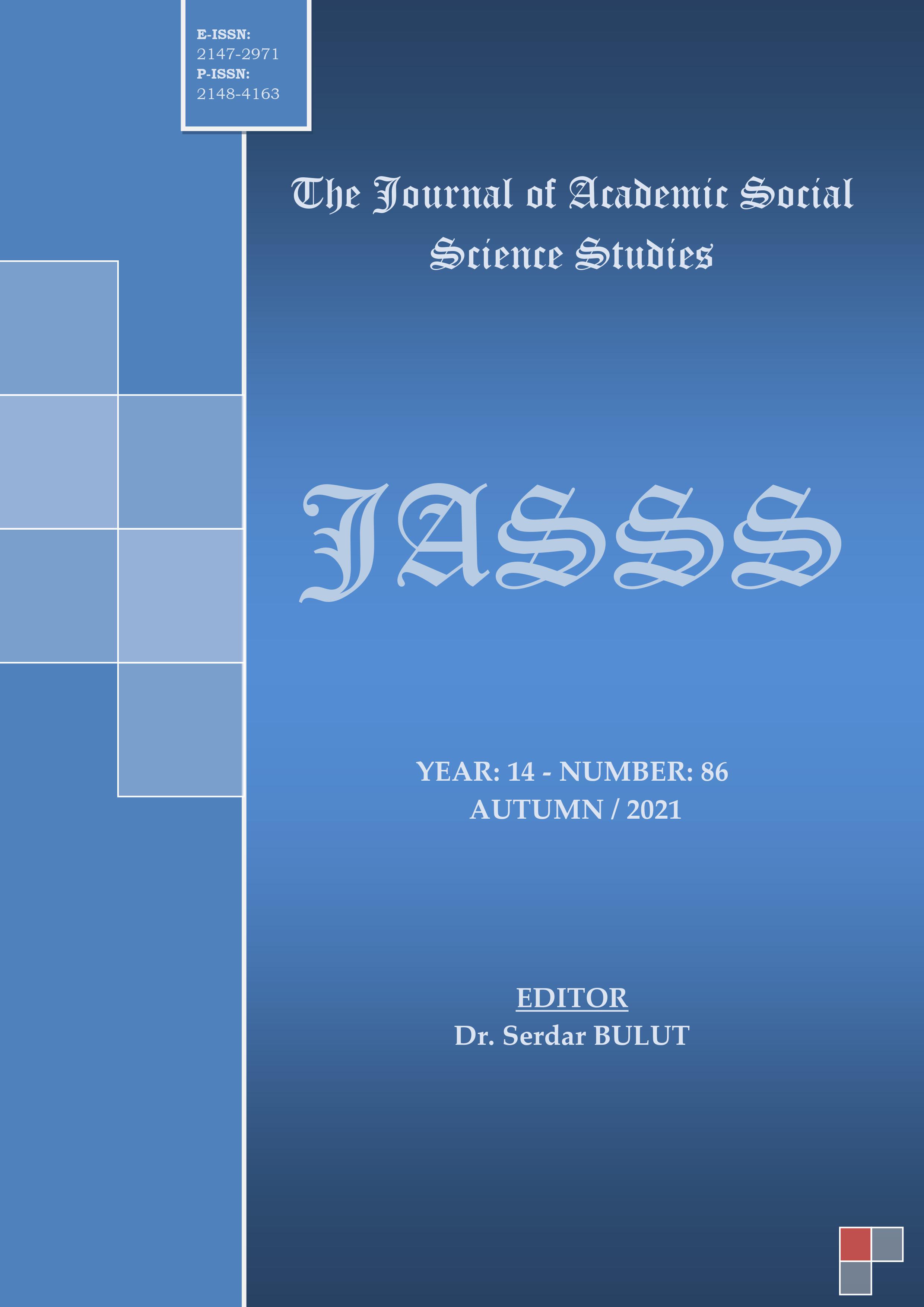Author :
Abstract
Ataerkil toplumlarda kadına yönelik baskı ve hüküm sürme yetisi daha fazladır. İnsan neslinin tek taraflı bakış açısıyla üremesi, yaşamsal sistemin dengesini bozmaktadır. Denge, yalnızca iletişimde değil cinsiyetler üzerinde de sağlandığında anlamlı hale gelir. Bu durum bireylerin karakteristik yapısını da eyleme döker. Tek taraflı fikirler, insan neslinin üremesi üzerinde bir otorite kurduğunda eylem bozulduğu gibi bireylerin nesiller boyu karakteristik yapısını bozmakta, kültürel süreçlerini, olumlu aktarımlarını sekteye uğratmaktadır. Sabır Taşı, yozlaşmış ahlaki ve geleneksel yaşam tarzlarının yol açtığı olumsuz sonuçları ifade etmesi ve bu sistemin yeniden yapılanmasına dikkat çekmesi bakımından önemlidir. Roman, Lucien Goldmann’ ın oluşumsal yapısalcı yöntemi üzere incelenmiştir. Oluşumsal yapısalcı yöntem içinde bulunan geriye dönüş tekniği, montaj tekniği, diyalog tekniği, iç diyalog tekniği, dinsel düzel, kültürel düzey, ekonomik düzey ve simgesel çözümleme başlıklarına yer verilmiştir. Eserde bulunan imgelerin evrensel gerçeklerine yer verilmiş ve eseri evrensel boyuta taşıyan yönleri üzerinde durulmuştur. Toplumsal yozlaşmaların nedenlerine dair varoluşsal tespitler yapılmıştır. Bu tespitler Tao, Kuran ve bilinçaltına dair bilimsel verilere dayandırılarak açıklanmıştır. Eserin bu şekilde çok yönlü olarak algılanması sağlanmıştır. Doğu toplumlarındaki kadın kavramının konumu üzerinden eserdeki simgeler geniş bir şekilde açıklanmış ve kadın kavramına bakış açısı kadını evrensel olarak anlama düzeyine çekilmiştir.
Bu çalışma, toplumda ahlaka dayandırılan yanlış yapılanmaların neticelerindeki temel sebepleri ortaya koymak, kadın-erkek eşitlik anlayışının gerekliliğini ontolojik açıdan vurgulamak amacıyla yazılmıştır.
Keywords
Abstract
In patriarchal societies, the oppression and the ability to dominate women are relatively higher. The reproduction of the human generation with a one-sided perspective disrupts the balance of the vital system. Balance becomes meaningful when it is achieved both in communication and in the genders. This situation also puts the characteristic structure of individuals into action. When one-sided ideas establish an authority over the reproduction of the human generation, they not only distort the action, but also disrupt the characteristic structure of individuals for generations, and disrupt their cultural processes and positive transfers. The Stone of Patience is important in that it expresses the negative consequences of corrupt moral and traditional lifestyles and draws attention to the restructuring of this system. The novel has been studied in the formative structuralist method of Lucien Goldmann. The headings of retrogression technique, montage technique, dialogue technique, internal dialogue technique, religious level, cultural level, economic level and symbolic analysis, which are included in the formative structuralist method, are included. The universal truths of the images in the work are included and the aspects that carry the work to the universal dimension are emphasized. Existential determinations have been made about the causes of social corruption. These determinations are explained on the basis of scientific data on the Tao, the Qur'an and the subconscious. In this way, the work has been perceived as multifaceted. Through the position of the concept of woman in eastern societies, the symbols in the work are explained in a wide variety and the viewpoint of the concept of woman is brought to the level of universal understanding of women.
This study was written with the aim of revealing the main reasons for the results of the wrong structures based on morality in society and emphasizing the necessity of the understanding of equality between men and women from an ontological point of view.
Keywords
- Acarsoy, F. (2016). Cinsel Kimya. İstanbul: Mona Yayınları.
- Açıkyıldız Şengül, B. (2014). Ezidilik Dininde Melek Tavus İnancı ve İkonografisi. Kürt Tarihi Dergisi, s.15, 10-17.
- Atalay, İ. (2016). Yapıt Çözümlemesinde Toplum Eleştiri, Yazın Toplumbilimi Yöntemleri ve Lucien Goldmann’ın Oluşumsal Yapısalcılığı. Humanitas. s. 4 (8), 387-412.
- Azap, S. (2017). Tölögön Kasımbekov İnsan ve Eser. Ankara: Bengü Yayınları.
- Demiryürek, M. (2013). Kurgusal Metinlerde İkinci Kişili Anlatıcı ve Bakış Açısı. FSM İlmi Araştırmalar İnsan ve Toplum Bilimleri Dergisi, 0 (2) , 119-139.
- Doğan, Ş. (2014). Orgazm ve Özgürlük Arasında Bir Bağlantı mı Var?. Psikeart Dergisi s. 32, 30.
- Erich, F. (2003). Sevme Sanatı (Çev. Özden Saatçi Karadana). İzmir: İlya Yayınları.
- Kefeli, E. (2011). Bellek-İnsan-Eser: Cengiz Dağcı. İstanbul: Ötüken Yayınları.
- Körük, S. (2018, 26 Mayıs). Nadia Anjuman (Blog yazısı) Erişim adresi: http://sevdenurkoruk.blogspot.com/2018/05/nadia-anjuman.html.
- Moran, B. (2010). Edebiyat Kuramları ve Eleştiri. İstanbul: İletişim Yayınları.
- Nietzsche, F. (2015). Putların Alacakaranlığı. (Çev. Ankara: Nilüfer Yayınları.
- Önal, M. (2010). Edebiyat ve İletişim. Ankara: Özbay Ofset Matbaacılık.
- Rahimi, A. (2010). Sabır Taşı (Çev. Volkan Yalçıntoklu). İstanbul: Can Yayınları.
- Sami, S. (2010). Kamus-ı Türki. İstanbul: Çağrı Yayınları.
- Stevick, S. (2004). Roman Teorisi (Çev. Sevim Kantarcıoğlu). Ankara: Akçağ Yayınları.
- Şahin, Ö. ve Sönmez, A. (2018). Çekirdek İnanç. Ankara: 72 Tasarım.
- Tekin, M. (2011). Roman Sanatı. İstanbul: Ötüken Yayınları.
- Yalçınkaya, F.H. (2009). Ankebut Kuran-ı Kerim’in Issız Derinliği ve Sembolik Analizi. İstanbul: Şira Yayınları.
